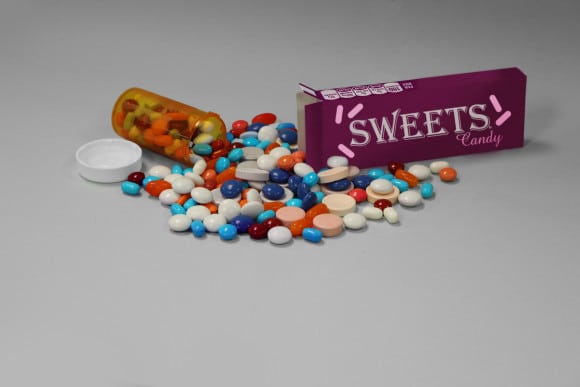It’s a favorite holiday for a lot of kids (and grown-ups)… you know, the one where you get to stuff your face with a ton of candy! But when your kids are looking for every candy bar they can find, they might think some stuff around the house is a treat when it definitely isn’t. Did you know that more than 300 kids are treated EACH DAY in emergency rooms because of unintentional poisoning? Two of those children will lose their lives. The American Association of Poison Control Centers reports in 2013, U.S. poison centers answered more than 3.1 million calls, including 2.2 million about humans and poison. Just under half involved kids under six, and many of them swallowed harmful substances like household chemicals and medicines. Those are often mistaken for toys or candy. And it’s no wonder.  Open up your medicine cabinet. Take a look. Check out what you’ve got under the kitchen sink. Ever notice how much a breath mint looks like an aspirin? Or that pain killers look just like jelly beans? What about those oil-based cleaning products? Kids might think they’re apple juice. Even those most common cleaning sprays can look like flavored water or some of your kid’s favorite juice packs. If you have a hard time telling the difference… imagine what your kids see. This Halloween let’s make sure kids are getting harmless tricks and tasty treats with these easy reminders. Reduce the Risk Parents – it’s your job to keep anything that might seem like a tasty treat AWAY FROM KIDS. Stick it in the garage or in a locked cabinet, somewhere your children can’t get to it. This means things like:
Open up your medicine cabinet. Take a look. Check out what you’ve got under the kitchen sink. Ever notice how much a breath mint looks like an aspirin? Or that pain killers look just like jelly beans? What about those oil-based cleaning products? Kids might think they’re apple juice. Even those most common cleaning sprays can look like flavored water or some of your kid’s favorite juice packs. If you have a hard time telling the difference… imagine what your kids see. This Halloween let’s make sure kids are getting harmless tricks and tasty treats with these easy reminders. Reduce the Risk Parents – it’s your job to keep anything that might seem like a tasty treat AWAY FROM KIDS. Stick it in the garage or in a locked cabinet, somewhere your children can’t get to it. This means things like:
- Vitamins
- Cleaning products
- Eye drops and contact solution
- Laundry products
- Nail polish
- Make-up
- Batteries
- Bug and weed killers
- Cigarettes
- Alcohol
- Mouthwash
- Plants
Another tip? Check out your world through their eyes. Kiddos think bright colors and candy-shaped boxes look like treats, no matter what’s inside. Share the Knowledge Here’s a scary statistic – more than 90 percent of poisonings happen at home. That means you have to be extra careful when visiting family or friends, or when your kids are with the babysitter. Make a list of emergency contact numbers and keep them in plain sight. The CDC recommends these tips to avoid accidental poisonings:
That means you have to be extra careful when visiting family or friends, or when your kids are with the babysitter. Make a list of emergency contact numbers and keep them in plain sight. The CDC recommends these tips to avoid accidental poisonings:
- Secure containers after you use them.
- Don’t let young kids be around household cleaners or gardening products without adult supervision.
- Leave the original label on all your products.
- If you get distracted with something else when taking medicine, like a phone call, take your kids with you.
- Take medicine in a well-lit area to make sure you take the right amount and don’t drop anything on the floor.
- Never call medicine “candy.”
- Install child-resistant latches on all cabinets and drawers. Buy extra sets and share with grandma and grandpa when your kids might be visiting.
There’s no substitute for paying attention. No matter how many child proof tools you have at home, always keep an eye on children. Know the Signs Watch for signs your child might have gotten their hands on something they shouldn’t have. Suddenly throwing up, acting loopy or super sleepy out of nowhere or seeing signs of the product on your child’s nose, mouth or on their breath. If you suspect a child has swallowed a hazardous chemical or medication, call 9-1-1 right away! You should also teach your kids to spot the signs of a potential poisoning in their friends and siblings. Do some role playing so they can practice what to do. Make it easy for them to find help fast. Here’s to a safe and Happy Halloween!



